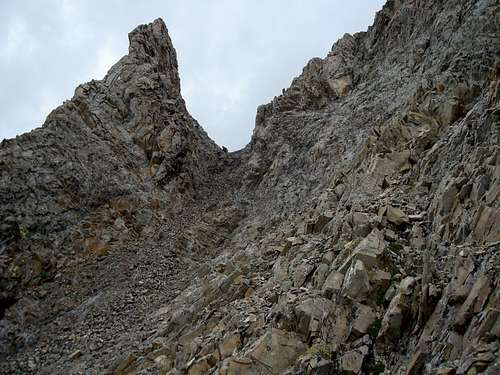-
 1896 Hits
1896 Hits
-
 79.04% Score
79.04% Score
-
 10 Votes
10 Votes
|
|
Route |
|---|---|
|
|
44.13550°N / 114.6581°W |
|
|
Hiking, Scrambling |
|
|
Summer, Fall |
|
|
A long day |
|
|
Class 4 |
|
|
Overview
White Cloud Peak #5 (WCP-5) is located in the highly scenic northern White Cloud Mountains of central Idaho. The south ridge route follows an infrequently maintained trail to within three-quarters of a mile and 1100’ of the summit. But that last 1100’ requires some effort, topped off by about 50’ of steep exposed Class 4 scrambling on deceptively loose rock. Along the way, you will be rewarded with great scenery that you’ll likely have all to yourself.
Getting There
All of the most likely approach routes used to reach WCP-5 begin in the Northern White Clouds at the Slate Creek trailhead. To reach the trailhead, make your way to the scenic town of Stanley, and then head northeast on Highway 75 for about 24 miles (or 34 miles southwest from Challis). Just after the highway crosses the Salmon River, look for a turnoff to the right (south) for Slate Creek. Follow this dirt road for 0.8 miles until you reach a fork. Take the left branch and follow the Slate Creek Road (FS666) until it ends at around 7 miles from the highway. The trailhead is accessible by passenger cars.Route Description
From the Slate Creek trailhead, follow the trail past the Slate Creek Hot Springs, some old mine buildings, and mounds of silty tailings to a creek crossing. Just after crossing the creek, the trail forks with the right branch leading to Hoodoo Lake. For WCP-5, take the left branch leading to Ocalkens Lake. The fork was hard to spot in summer 2009 since someone had recently covered the trail with brush, but look for a path just after a chest-freezer sized piece of rusty mining equipment. The trail makes its way through patchy forest for the first 4 miles to Ocalkens Lake, then heads uphill to a 9600’ saddle at the eastern end of Iron Basin. The views from the saddle are impressive, with 11ers Calkens Peak, WCP-9, and David O. Lee Peak right in your face.
From the Iron Basin Saddle, you have a couple options. Either climb the south ridge of WCP-6 (recommended) and traverse the ridge to WCP-5, or descend about a half mile and 100’ into Iron Basin and climb the loose scree and talus on the south face of WCP-5 until you gain the ridge. This second option makes a pretty good descent route, but is a pain to climb up.
Continue up the southeast ridge of WCP-5 on game trails until it becomes too steep, and you are pushed out onto the south face. Angle out onto the face until your are looking up the steep and loose gully that leads to a notch between the twin summit towers. There is loose rock inside the gully, but more stable Class 3 footing can be found just to either side. Follow the gully to the notch, and climb 30 feet to the lower Class 3 western summit if you like, or climb 50 feet up the Class 4 eastern summit to the true highpoint. The rock is deceptively loose in places, so test all holds before trusting them. The crux is the descent, so make sure you’re comfortable with the down-climb before heading up from the notch.
- Distance (round trip): 11.1 Miles
- Elevation Gain (cumulative): 3700 Feet (add 300 feet if tagging WCP-6 along the way)
When To Climb
The summer climbing season in the White Clouds is typically from July until the snow flies in October. A visit earlier in the year may be feasible, but would require crossing a couple streams swollen by snow run off, and the approach could be longer depending on spring road conditions leading to the Slate Creek trailhead. A winter ascent would be very challenging due to the long approach.
Essential Gear
No technical gear should be required on this Class 4 route. A rope could be used on the descent from the summit block, but may not be worth the carrying weight. Consider bringing along a helmet due to loose rock in the gully leading to the notch between the summits. Climbing carefully and providing adequate spacing between you and your climbing partner to avoid rock-fall danger






